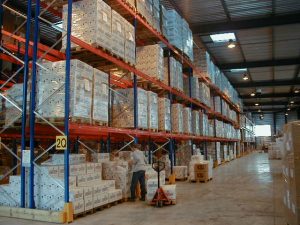
Most companies understand that inventory costs money, but few understand why inventory becomes more expensive the longer it’s held. Still, even fewer companies take the time to track the impact of the cost of money on their inventory. When thinking of the cost of money, think of your company’s costs to purchase and retain parts and raw materials for long periods. Think of your company’s financing costs, how those costs rise over time and ultimately, what drives those costs. More importantly, think of how long it takes to sell that inventory and how certain customers can increase these costs by taking too long to pay their invoices. Holding that inventory before it’s finally sold is one financing cost. Another is waiting for customers to finally close their invoice.
In order to get an idea of these financing costs, think of how your company uses business loans and credit lines to finance the purchase of parts and raw materials. These financing tools have a yearly interest rate that can be converted into a daily interest rate. Every day your company holds inventory it doesn’t sell, is yet another cost to your company. In fact, your company will continue to cover the cost of money up to the point where your customer pays their invoice. The longer the customer takes to pay that invoice, the more expensive it becomes. This is why so many companies complain about having to finance their customer’s business. In essence, your company can become your customer’s bank. Except in this case, your company is essentially charging a 0% interest rate. It’s the reason why customers extend their terms and why some prefer to wait before finally paying. Again, every day your company holds inventory is one cost. The longer your customers take to pay their invoice is yet another. So, just how bad can it get? To answer this question, we’ll look at an example of how the cost of money can impact your company’s gross profit and increase your inventory financing costs.
The impact of the cost of money on inventory & gross profit
Gross profit is calculated by taking net sales and deducting the product’s COGS (cost of goods sold). Let’s assume a given product sells for $15,000.00 and that its COGS are $10,000.00. The gross profit on the sale would therefore be $5,000.00. Now, let’s assume the company’s yearly interest rate on its credit line is 5%. To determine the company’s daily cost of money would involve dividing this 5% by 365 days in a year. Doing this would give us a daily interest rate of 0.0137%. This daily interest rate would then be multiplied by the COGS in order to give us the company’s daily cost of money. In this case, it is $1.37 for each day the company retains the inventory and doesn’t sell it, and every day the customer’s invoice goes unpaid. For example, if the company held that inventory for 30, 60 or 90 days, its costs would be substantial. Over 30 days the company’s inventory support costs total $41.10. After 60 days it increases to $82.19 and after 90 days it increases to $123.29. Now, what happens after the product is finally shipped and the customer takes 30, 60 or 90 days to pay their invoice? The answer is simple. Every one of these costs above would be doubled. After reviewing this situation, it becomes fairly obvious that while $1.37 may not sound like much, once you factor in time, it quickly adds up and reduces the company’s gross profit on the sale.
- Net sales: $15,000.00
- COGS: $10,000.00
- Gross profit: $5,000.00
- Yearly interest rate: 5%
- Daily interest rate: 0.0137%
- Daily cost based on COGS: $1.37
- Financing costs for 30 days: $41.10
- Financing costs for 60 days: $82.19
- Financing costs for 90 days: $123.29
It’s important to note that we’ve only discussed the company’s financing costs of inventory as it relates to its yearly & daily interest rates. In order to get a true indication of the company’s overall inventory costs, the company would have to determine their monthly carrying charges and apply them to the amount of time they held the inventory before it was sold, and the amount of time it took the customer to pay their invoice. To give you an idea of just how expensive this can be, a number of companies apply a standard monthly carrying cost of 3% and apply it to their COGS in order to determine their overall costs to support inventory.
A number of individuals look at the aforementioned example and rationalize the cost of money. After all, how much impact can $1.37 in financing costs really have? Well, to provide you with some perspective, ask yourself the following question. How much sales must your company generate in order to produce $1.00 of profit? Not sure of the answer? If so, it’s about time you figured it out. The purpose of this is to drive home just how expensive your company’s inventory financing costs can become. Every dollar saved in inventory costs goes directly to improving your bottom line. In essence, if it took $10.00 in sales to generate $1.00 of profit, then every dollar saved in inventory costs is akin to 1000% return on investment! This is the reason why some companies advocate giving procurement and inventory professionals gross profit objectives.
The purpose of this exercise is to be cognizant of these costs and understand their impact on your supply chain and inventory management strategies. For instance, Min/Max inventory approaches are sometimes viewed as outdated. However, when it comes to servicing a cyclical and seasonal market, where customer order frequency is unpredictable, few approaches work as well as Min/Max. While the company’s carrying costs of inventory tend to be higher, these costs can be offset by using economies of scale to lower pricing and freight costs on incoming parts & raw materials. In addition, running this type of inventory system helps to guard against lost sales due to low inventory. In terms of JIT (Just in Time) or Dell’s “Push-Pull”, these holding costs are offset because the company only purchases what it needs to fulfill current demand. However, these strategies require high volume, large economies of scale, and a strong market position in order to drive down costs. Unfortunately, very few companies have the clout and ability to make JIT work to its fullest. In addition inaccurate inventory counts or late supplier shipments means costs are more severe for those companies running JIT.
